Contents
There comes a time when domestic animals specially raised for meat have to be slaughtered and cut into pieces for further storage. Cutting a pork carcass is a responsible occupation that requires compliance with certain subtleties. Following the correct cutting patterns will allow you to get quality products.
General rules for cutting carcasses after singeing
The slaughtered animal, which has already been bled and scorched, is ready for further processing. Compliance with the sequence will help with the correct cutting of the pig and will be the key to quality meat. First you need to select the necessary tools:
- utility knife with a blade length of at least 18 cm;
- an ax for cutting bones;
- hacksaw with fine teeth.
The ideal condition for further cutting is the suspension of the carcass. In this state, the muscles are stretched, which contributes to a more comfortable butcher’s activity. In addition, this position allows you to more effectively get rid of excess blood when separating the head. If hanging the pig is not possible, a deep drain pan should be used. The carcass itself is placed on the ground on a dense tarpaulin or spread out straw.
It is very important to remember that not all parts of the pig are edible. Therefore, when cutting, it is worth removing the eyes and teeth. It is also worth getting rid of the tail and hooves of the animal.
Schemes for cutting pork carcasses
There are several schemes for cutting pigs, depending on further processing and purpose. Despite the variety of options, the most valuable part of them are the muscles that, during the life of the animal, strained less than the rest. Most often, these parts of the body include the muscles of the spine. Unlike cows, the pig’s neck is not as mobile during life, so this meat is valued quite highly. The lower parts of the animal have tougher meat and are less valuable in further use.
Scheme of cutting a pork carcass

Butchering for personal needs and for sending to stores is technologically significantly different. There are four classic versions of cutting in the world:
- American;
- German;
- ;
- English.
Each has its own characteristics.
Cutting patterns for culinary use
The American method involves the division of the carcass into two longitudinal half-carcasses. Then each of them is divided into 6 parts. As a result, the consumer receives: ham, front ham, shoulder, fillet with ribs, side and head.
The German method involves cutting the carcass into two half-carcasses, each of which is further divided into eight parts. Each of the parts belongs to one of four varieties. For example, the top grade includes the back ham, cutlet and lumbar. The second includes the brisket, the front of the ham and the neck. The third category of the German method includes the peritoneum. Finally, the head and hooves are the 4th category.
The carcass cutting scheme implies 8 different parts. This method is popular throughout the post-Soviet space. After processing, the following is sent to consumers:
- ham;
- cutlet part (back);
- neck (the place between the shoulder blade and the head);
- cheeks, head and neck;
- scapula;
- brisket;
- middle section of the leg;
- legs.
The English method is simple and clear. A whole pork carcass is divided into four large parts. After the English cut, the farmer receives the head, the front part with the neck and shoulder blade, the central part with the spine and ribs, the back part – the ham.
How to Butcher a Whole Pig
The most important part of cutting a pig carcass is the gut. First of all, you should separate the head from the body. Since a well-fed pig has a thick fat layer and a massive spine, it is necessary to take care of the sharpness of the knife and ax in advance. After separating the head, it is worth draining excess blood into a previously prepared container.
The next stage of cutting is the opening of the abdominal cavity. For correct execution, you need to find a point on the chest line. Cutting is made from it to the inguinal region. In order not to damage the internal organs, it is necessary to lower the hand just below the knife blade and do this operation with extreme care. After that, it is necessary to make an incision from the same point on the chest, removing the peritoneum along the line of the ribs.
Next comes a very important moment of removal of internal organs. Particular attention should be paid to the esophagus, since the liquid and enzymes contained in it, if it comes into contact with meat, will require additional washing. After the esophagus, the remaining organs of the upper part of the carcass are removed – the heart, lungs, liver. Then the bladder and intestines with the stomach are carefully removed.
It is necessary to decide in advance whether certain organs will be needed in the future. So, if necessary, use the intestines, it is carefully removed and washed with running water. In order to use the heart in the future, it should be cut in half and the remaining blood drained from it. The rest of the offal should be lightly washed and put in the refrigerator.
The next part of the cutting is cleaning the internal cavity of the carcass. In no case should you use ordinary water, because if it gets on the meat, it spoils its appearance and leads to a decrease in its shelf life. The treatment of the inner surface should be carried out with a clean towel, absorbing the remnants of blood and wiping dry.
How to properly cut a pork carcass
The carcass is ready for the next part of the cutting – cutting into half carcasses. The incision line should run along the spine, so the use of a knife is undesirable. Cutting takes place with a hacksaw or a well-sharpened ax. Beginners often fail to make the correct cut of the spine the first time. To avoid getting bone fragments into the meat, you can use the following secret – hit the butt of the ax with a heavy hammer.
Often the prepared carcass is divided not into two parts, but into four. A quarter means dividing a half carcass into two equal halves. To perform such an operation, it is necessary to cut it approximately in the middle of the lumbar part. Thus, it turns out 2 pieces of pork – the front part with the shoulder blade, neck, front leg, and the back part – with the ham and cutlet part.
How to butcher a pig
To properly butcher a piglet at home, you must follow the same processing rules as with adults.
If the goal of harvesting meat is not an adult fattened pig, but a small piglet, then the cutting method changes slightly. Of course, in terms of anatomy, the young and the adult do not differ, but there are several nuances. When gutting a piglet, you should not pay such great attention to the removal of the kidneys and the genitourinary system. In addition, the bones of a young piglet are softer, so in some cases even using a knife instead of an ax is allowed. The carcass splits more easily.
How to butcher a half carcass of a pig at home
Each farmer has his own cutting scheme that suits his requirements. However, there is a classic correct option for cutting a pig carcass at home, which is able to satisfy the needs of the consumer. Some prefer to get more fat from one carcass, others are chasing the purest meat, spending a huge amount of time on trimming and deboning. There are people who even twist all the meat into minced meat. For the correct cutting of pork carcasses according to the canons of the methodology, it is still worth paying attention to the fact that each part of the carcass is important and applicable in the future.
How to butcher the front or back of a pig
The front part of the half carcass is cut into the neck, shoulder blade, brisket, shoulder, loin and ribs. First cut off the front leg. Then, with the help of a hatchet, the ribs are removed. Next comes the turn of the loin – it is separated and, if desired, cut into portioned pieces. The remaining piece is conditionally divided in half into the upper neck and lower shoulder blade.
The back is represented by a large leg, peritoneum and back of the spine. First, the peritoneum is cut off, then the spine is cut off from the leg. The tenderest part of the meat, the tenderloin, is cut off from the spine. The bones of the spine are also used as the basis for broths.
How to butcher a pig’s leg
From the remaining pork leg, cut off the lower part – the knuckle. The remaining large piece with bone is often cut into large pieces or lived along the muscles. There are two large muscles in the leg that are conveniently separated from one another. The resulting meat from a large muscle will be devoid of body fat and is perfect for preparing a huge number of dishes. The meat from the small muscle adjacent to the bone is tougher, often left directly on it for later use in soups and stews.
How to remove fat from a pig carcass
Many farmers raise pigs for lard and lard. In this case, the method of cutting the pork carcass is slightly changed. Prepared half-carcasses or quarters are skinned with adjacent fat. With proper fattening, the fat layer easily reaches 10 centimeters or more. The most suitable part for removing fat is the peritoneum and sternum. Pure fat is obtained from the peritoneum, and a product with a large number of meat layers from the sternum.
As for lard, it is soft lard, intended for kindling or preparing a variety of spreads. The largest amount of lard is found above the ham in the tail area. In addition, fat can be cut off from other fatty parts of the body, such as the shoulder blade or shoulder.
Which part of the pig is better: front or back
The debate about which part of the pork carcass is better does not stop for a day. On the one hand, the back part is represented by a ham and a lumbar tenderloin. These types of meat contain little fat and are great for diet meals. It is the absence of fatty layers that explains their special popularity.
On the other hand, the front part of the carcass is more oily. At the same time, you should not think that all meat belongs to a lower category. On the contrary, in the front part of the carcass there is a brisket and a loin – the most delicate parts that have long proven themselves in cooking. The shoulder cut also contains a large amount of meat, which is excellent for minced meat. Barbecue lovers also do not stand aside – the pork neck is the best area for cooking this dish.
Types of pork meat when cutting
According to the modern classification, retail chains offer various varieties of pork. There are three varieties depending on the quality of the meat, its softness and other indicators. So, the first class includes:
- dorsal and sirloin parts;
- sternum;
- ham (rump, tail and round).
Meat of the first grade due to the least load on the muscles during the life of the animal, has a soft structure. Pieces of the ham and the back part can boast of juiciness and almost complete absence of fat. The brisket is valued in the culinary community for the ribs, and with proper nutrition of the animal, they are covered with a large amount of tender meat.
Meat of the second grade is no longer so tender. It has a large amount of veins and fat. This variety most often includes shoulder, neck, shoulder and arable land. Most often, such meat is processed into minced meat, since the process of trimming does not pay off labor costs.
The third grade includes inedible parts of pork, for example, a cut – a part between the head and neck of a pig, which, in terms of meat structure, differs significantly for the worse from the same shoulder blade. In addition to the cut, the head, front and rear shank are also distinguished in this variety.
Parts of pork with the name, photo, application
The end result of the correct cutting of pork carcasses is a certain set of meat products. Each of these parts differs both externally and in a set of its consumer qualities.
Brisket
The brisket is the thick part of the ventral cut in the lumbar region. The meat, depending on the fattening of the pig, contains a fairly large fat layer. Due to the immobility of the pectoral muscles, the meat is very tender. According to GOST, it belongs to the first category of pork.
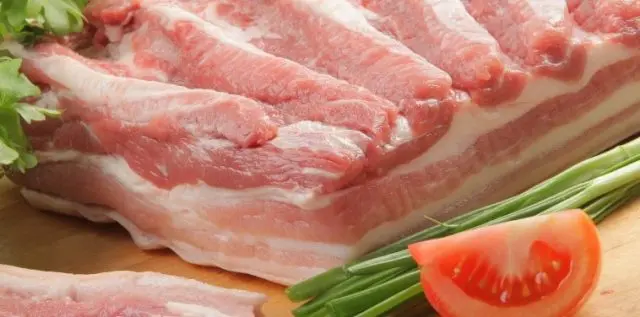
Thanks to the fatty layer, the brisket is great for frying. Moreover, both as an independent dish, and as an addition to potatoes or cabbage. Also, the brisket is salted and marinated, getting excellent delicacies. One of the best uses for brisket is smoking it – the resulting product has an unsurpassed aroma and taste.
Neck
The neck is part of the scapular-cervical cut. Due to the physiological characteristics of pigs, this part is inactive compared to other animals. This causes the content in it of a large number of fatty layers and the complete absence of tendons. The meat is very juicy and tender.
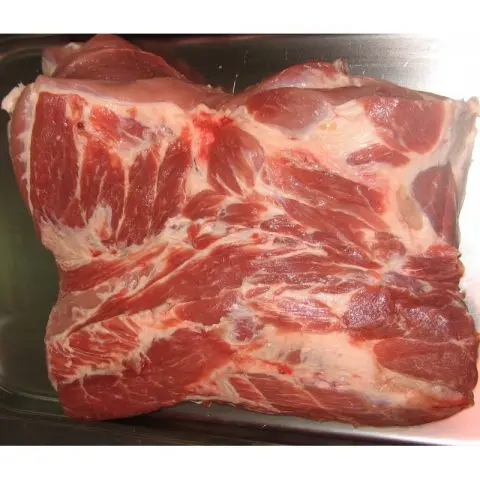
The boneless neck belongs to the second category of pork, but is one of the favorite parts of the pork carcass. It remains an ideal part for cooking barbecue – thanks to the fatty layers, the meat will turn out very juicy. The neck is also used for cooking fatty steaks. Minced pork neck is the perfect choice for making cutlets.
Entrecote
Entrecote or loin on the bone – the upper part of the dorsal cut. It includes tenderloin and ribs. Such meat belongs to the first category due to the most tender pulp. Cut into pieces, the entrecote is a cutlet on the bone, highly valued by gourmets.
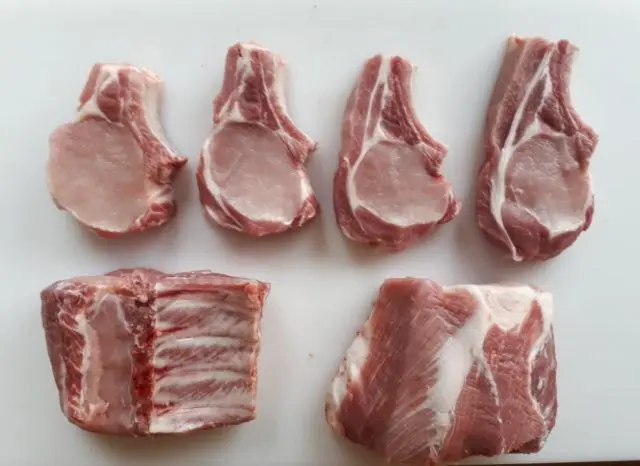
With its juicy meat and bone that gives extra flavor when fried, entrecote is the king of pork steaks. Dishes are juicy and delicate in taste. Often this part of the pork is stripped from the ribs, resulting in a clean piece of tenderloin. The ribs go for soups and stews.
Schnitzel
Schnitzel, aka boneless loin – pork tenderloin from the lumbar part of the carcass. This part of the carcass is the most valuable due to the complete absence of fat in its structure. For value belongs to the first category of pork. As a result, the price for such a piece of pork is often the highest.
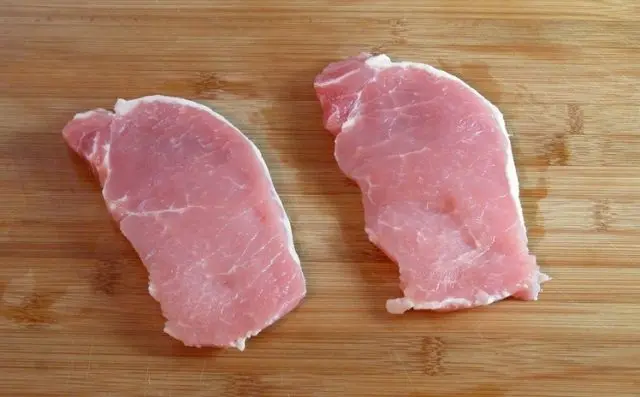
When cutting this part, the same beautiful pieces of meat are obtained. Schnitzel is used to prepare various chops and steaks. In addition, this part is used for cooking dietary dishes.
Scapula
The shoulder cut is divided into a boned shoulder blade and a boneless shoulder blade. This type of meat belongs to the second category due to the high content of fat and tendons. The shoulder blade is tougher than the ham or sirloin, so its prices are more affordable.
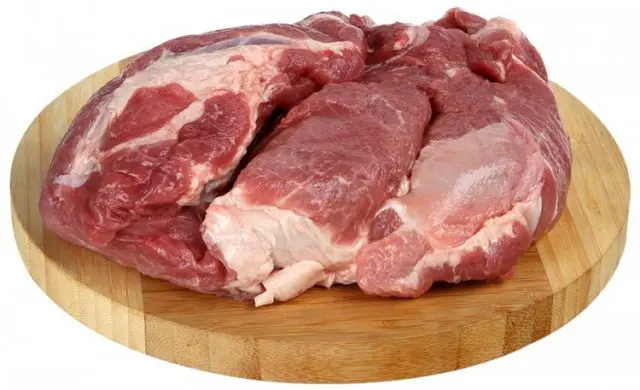
The shoulder without the bone is usually cut into cubes for making stir-fry and goulash. The more sinewy part on the bone requires serious processing and careful trimming. Often this part of the pig goes to the preparation of minced meat. However, this proportion is still well suited to various stews.
Ham
The ham is the hind leg of a pig. Often it is divided into two parts – upper and lower. The upper part of the ham is a highly valued meat of the first grade, tender, with a small amount of fat. The lower part contains less meat and is used for making broths and aspics.

In terms of culinary uses, the top of the ham is a great find for cooking all sorts of dishes. Boiled pork, chops, goulash, various roasts and shish kebabs. This meat has proven itself well for cooking minced meat. Cutlets are tender and juicy.
What parts to apply where
The whole history of pig breeding is closely intertwined with the development of culinary arts. Experienced chefs over several centuries have formed general rules for the use of various parts of the carcass. Not all pieces are equally ideal for both jelly and chops. To learn how to cook real culinary masterpieces, you need to follow a few simple rules:
- Head – an ideal choice for cooking brawn and jelly. It can also be used for saltison and stuffing. Piglet and pig ears also open up beautifully in jelly. In addition, pig ears in various variations are ideal as a beer snack.
- Shikovina used for smoking. In order for the finished product to have excellent consumer properties, it must be cut into small pieces and subjected to prolonged heat treatment. After a few days, the cheeks will be smoked more strongly and become indescribably tasty. Some chefs advise baking the cheek in the form of rolls.
- Tenderloin, she is a loin and carbonade – pure meat. Served both in pure form and with ribs. The lean meat is often used in chops, kebabs, and steaks. The use of ribs makes for the perfect soup.
- Upper part of the ham – the rump, which is separated from the femur. A huge piece of boneless meat is ideal for cooking baked pork and boiled pork. Rump makes excellent juicy minced meat. Ham meat is suitable for goulash or frying. Ham bone is great for making borscht or pickle.
- Scapula most often used for making dumplings. Minced meat, obtained from this part of the carcass, has a small fat layer, which makes the dumplings juicy. Also, minced shoulder blades are often used as the basis for homemade sausages.
- Brisket can be used both in pure form and with adjacent ribs. Most often it is used to prepare smoked bacon or as an addition to scrambled eggs and fried potatoes. Bacon made from brisket is a delicacy of the highest quality.
- Peritoneum – one of the fattest parts of the pork carcass. Undercuts are great as an addition to fried potatoes or stewed cabbage. Also, delicious rolls are made from the peritoneum.
- Legs – the best choice for cooking jelly. In addition, European culinary specialists use them to prepare traditional dishes. So, in Germany, Austria and the Czech Republic, a knuckle with beer and stewed cabbage is a national dish.
- Many often underestimate pork tail. In fact, because of its cartilaginous structure, it is a great addition to jelly or brawn. The broth will become richer and set faster.
Cooks have long proven that there is no unnecessary meat, you just need to find the right area for its application. Even unused parts of pigs, such as the intestines, heart and liver, can be used to make real culinary delights.
Conclusion
Cutting a pork carcass is a laborious process that allows you to get a variety of products for cooking culinary masterpieces. Properly cut meat and its selection allows you to achieve impressive results in the preparation of familiar dishes.










Spareribs не са там, където ги показвате!